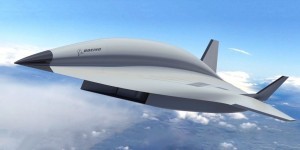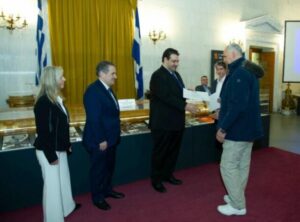This week Boeing revealed the first design details of a demonstrator aircraft that would go faster than Mach 5. Boeing hopes to build the hypersonic concept around a combined-cycle engine that incorporates elements of a turbine and a dual ramjet/scramjet. The unveiling came at the American Institute of Aeronautics and Astronautics SciTech forum in Orlando, Florida, as reported by Aviation Week Aerospace Daily.
Boeing’s model design is similar to one Lockheed Martin is working on. The aerospace industry right now is racing to produce a hypersonic strike and reconnaissance aircraft to replace the famed SR-71 Blackbird.
@Boeing takes wraps off Mach 5+ hypersonic ‘son of Blackbird’ contender at #AIAASciTech pic.twitter.com/P9fkfq5Xgx
— Guy Norris (@AvWeekGuy) January 10, 2018
The design is an early concept that’s not yet approved by Boeing for full-scale development. But the model, which shows a twin-tail, highly swept delta wing configuration, represents a feasible hypersonic design, Boeing’s head of hypersonic research told Aviation Week Aerospace Daily:
We asked, ‘What is the most affordable way to do a reusable hypersonic demonstrator vehicle?’ And we did our own independent research looking at this question,” says Kevin Bowcutt, Boeing chief scientist for hypersonics. If the concept is selected for full-scale development, Boeing envisions a two-step process beginning with flight tests of an F-16-sized, single-engine proof-of-concept precursor vehicle leading to a twin-engine, full-scale operational vehicle with about the same dimensions as the 107-ft.-long SR-71.
Boeing will expand on research from its past X-43 and X-51 Waverider experimental aircraft, which were tests of unmanned hypersonic planes, as the company refines a new aircraft design. The X-51 broke the record for sustained air-breathing hypersonic flight when it flew at Mach 5.1 for three and a half minutes before running out of fuel and crashing into the Pacific Ocean on May 1, 2013.
The big difference is that the X-51 was a small test vehicle dropped from a B-52 Stratofortress. It used a rocket booster to achieve Mach 4.8, then jettisoned the booster and used a scramjet to top Mach 5. A hypersonic replacement for the SR-71 would need to take off under its own power, accelerate through Mach 1 and up to above Mach 5, and then slow back down and land, a much more difficult challenge.
To tackle this problem, Boeing and Lockheed Martin are studying turbine-based combined cycle (TBCC) engines along with Orbital ATK and Aerojet Rocketdyne, respectively. A TBCC engine would use a conventional turbojet to achieve speeds up to about Mach 3, the limit for a turbojet, and then transition to a dual ramjet/scramjet, which must be traveling at speeds over Mach 3 to work properly, compressing air from the intake to achieve combustion without an axial compressor. The ramjet/scramjet would then carry an aircraft to speeds over Mach 5. The plane would need to transition back to to the turbojet to slow down and land.
Boeing’s project for a “son-of-Blackbird” hypersonic strike and reconnaissance aircraft is in its very early days. Meanwhile, a demonstrator for Lockheed Martin’s design was possibly spotted in Palmdale, California, near the Air Force plant where Lockheed’s Skunk Works operates. Work on a TBCC engine, funded under DARPA’s Advanced Full Range Engine (AFRE) program as well as by NASA and the U.S. Air Force Research Laboratory, is also still in the early stages.
It is difficult to put a timeline on the research or the potential flight tests, though Lockheed reportedly hopes to fly a single-engine scaled demonstrator known as the flight research vehicle (FRV) in the 2020s. One has to imagine Boeing wants to match Lockheed Martin’s development schedule, if not surpass it.
Source: popularmechanics
Ask me anything
Explore related questions





